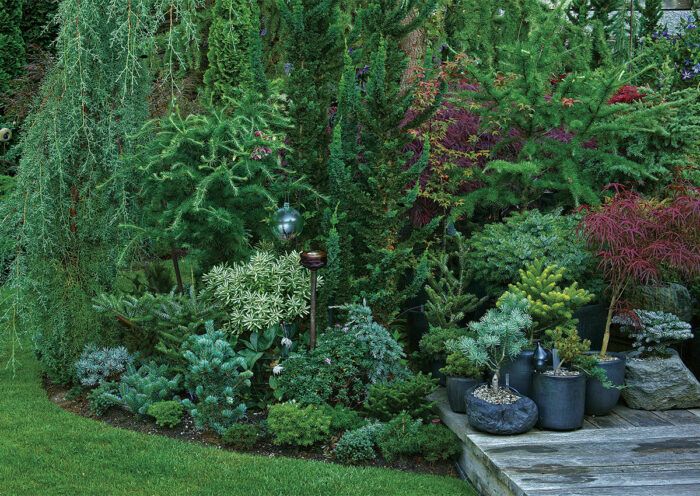
What is a conifer? We think of it as an evergreen plant with needle-like foliage, but a conifer is simply a plant that bears cones. And not all conifers are totally evergreen. Some are deciduous! There is more to this group of plants than meets the eye. Some of the most common genera of conifers are spruce (Picea spp. and cvs., Zones 2–8), fir (Abies spp. and cvs., Zones 3–8), pine (Pinus spp. and cvs., Zones 2–9), cypress (Taxodium spp. and cvs., Zones 5–11), juniper (Juniperus spp. and cvs., Zones 2–10), arborvitae (Thuja spp. and cvs., Zones 2–7), and cedar (Cedrus spp. and cvs., Zones 6–9). But how do you tell them apart? Learn how to identify a few common conifers here.
Conifers form the structural backbone of gardens all year round. During the growing season, they seem to fade into the background while perennials take the spotlight. But when winter approaches, with perennials fading away and leaves dropping from deciduous trees, conifers reclaim their spot in the foreground of the garden. In winter, it’s so much easier to appreciate the graceful forms and rich textures of these plants. Their broad range of colors, including every shade of green along with teal blues and chartreuse yellows, seem to pop against muted winter skies. And is there anything more charming than conifer branches dusted in snow or wrapped in twinkling lights?
With all that these plants contribute, it’s no wonder gardeners love them. They are relatively low maintenance, and many are extremely cold hardy. But not every conifer works in every situation. Learn which species and varieties work best for your garden, whether you’re looking for a specific color or growth habit, or to find a match for a certain condition. Next, learn how to design with conifers. There are more options for this diverse group of plants than growing them as single specimens or using them to form a border. With so many shapes and colors available, matching your garden scheme to your conifers (and vice versa) is important.
While these plants are generally thought to be easy to care for, some pruning may be required. Look below for tips on how to prune different types of conifers for different reasons. And last but not least, check out some growing tips to keep your plants happy and healthy for years to come.
-
 Design
DesignConifers to Consider
These slow-growing and dwarf varieties add color, texture, and shape to garden plantings
-
 Design
DesignConifers for Shade
Yes, you can grow evergreen trees and shrubs in shade. Who knew?
-
 Design
Design9 Cool Variegated Conifers
-

-
 Design
DesignComposing With Conifers
For a dynamic look, contrast different shapes and colors
-
 Article
ArticleDesigning with Conifers
-
 Design
DesignConifers Should Come First
-
 Design
DesignDesigning with Dwarf Conifers
Enjoy year-round interest without giving up your whole garden
-
 How-To
How-ToHow to Prune Conifers
These plants are unforgiving, so make the right cuts for the right reasons
-
 How-To
How-ToPruning Conifers for Health
-

-

-
 How-To
How-ToHow to Prune Pine Trees
-

-

-

-













